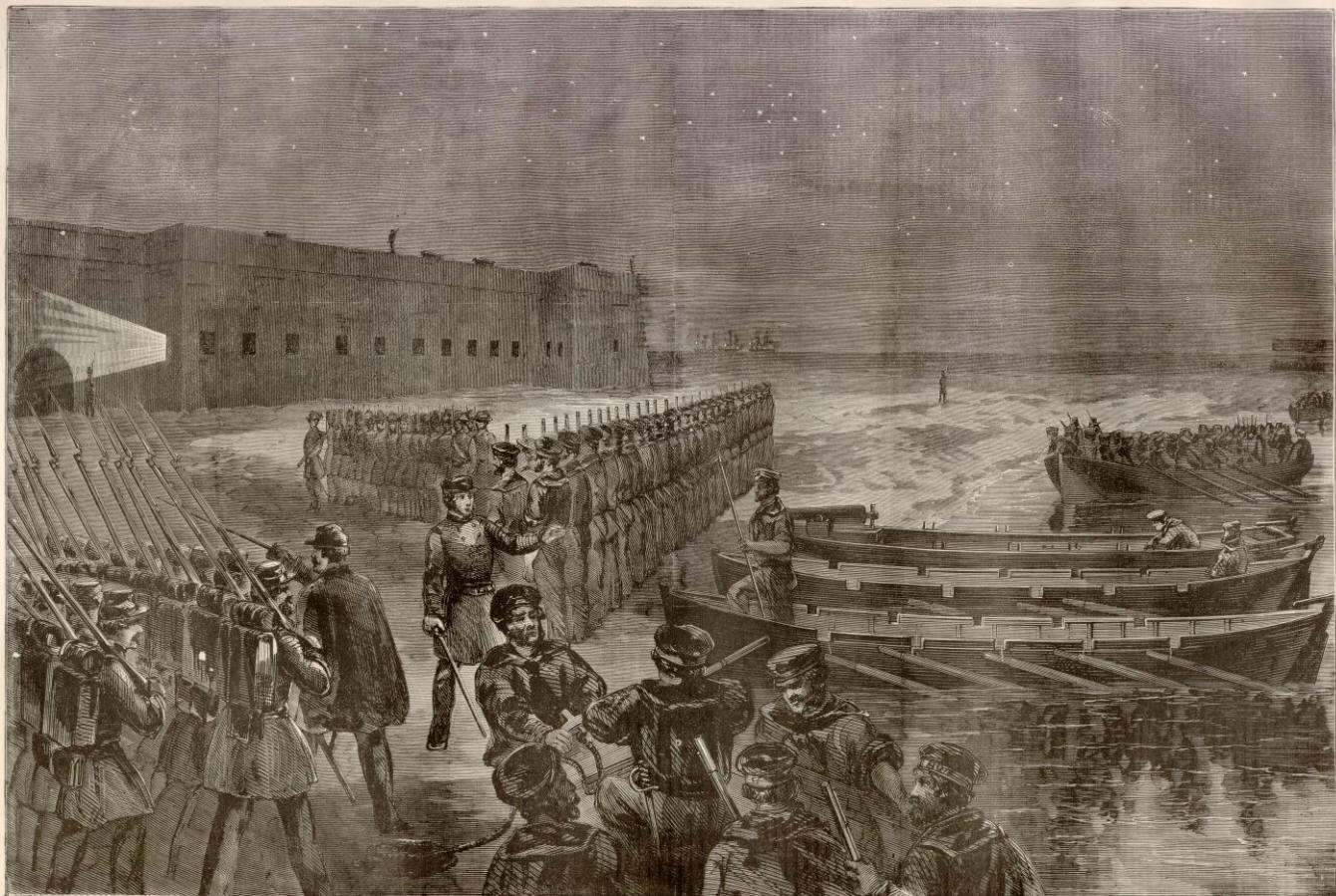[SIEGE OF FORT SUMTER] At 12:45 in the morning, the three Confederate messengers to Fort Sumter, Chestnut, Chisolm, and Lee, return to Major Robert Anderson at Beauregard’s request in a last ditch effort at a peaceful settlement. They ask Anderson for a time of probable evacuation. At 3:15am, he indicates noon April 15 as his target provided he receives no supplies or orders from Washington.
Floating Battery fires on Sumter
 |
| Charlestonians at the Battery watch the battle |
 At 4:25 am, Capt. James at Fort Johnson sends up a signal flare to the other harbor batteries to open fire followed by the first shot. Lieutenant Henry Saxon Farley, a South Carolina Militia volunteer from Laurens, South Carolina, pulls the first lanyard on a ten inch seacoast mortar at Fort Johnson at 4:25am. Thus, Confederate troops defend their inherent right of Independence and begin a rotation of fire on a foreign, invading power at Fort Sumter. Firing will continue throughout the day and at intervals through the night.
At 4:25 am, Capt. James at Fort Johnson sends up a signal flare to the other harbor batteries to open fire followed by the first shot. Lieutenant Henry Saxon Farley, a South Carolina Militia volunteer from Laurens, South Carolina, pulls the first lanyard on a ten inch seacoast mortar at Fort Johnson at 4:25am. Thus, Confederate troops defend their inherent right of Independence and begin a rotation of fire on a foreign, invading power at Fort Sumter. Firing will continue throughout the day and at intervals through the night.  The citizens of Charleston are frenetic, with many watching the bombardment from rooftops throughout the city. The Achilles heel of Fort Sumter is wood on the inside of the fort. Since he is low on cartridge bags, Major Robert Anderson holds his fire until 7:00am, when US Captain Abner Doubleday fires the first shot from Sumter on the Iron Battery at Cummings Point.
The citizens of Charleston are frenetic, with many watching the bombardment from rooftops throughout the city. The Achilles heel of Fort Sumter is wood on the inside of the fort. Since he is low on cartridge bags, Major Robert Anderson holds his fire until 7:00am, when US Captain Abner Doubleday fires the first shot from Sumter on the Iron Battery at Cummings Point. To protect his men, Anderson orders them to use only the 32 and 42 pound guns which are in the casemates instead of the heavier guns on the exposed top which could damage Southron defenses. In Fort Sumter, small fires are set by hot shot or bursting shells, but they are extinguished. Tonight, the Confederates slacken their fire, booming at twenty minute intervals; Anderson stops his fire.
 |
| The Baltic |
- Meanwhile at 3 o’clock in the morning and after three days of storms at sea, Captain Gustavus Fox on the Baltic, commanding Lincoln’s reinforcement fleet and the last straw as far as the Confederates are concerned, arrives at the rendezvous point ten miles outside Charleston Harbor. The Harriet Lane had arrived a few hours earlier, and at 6:00am the Pawnee arrives. There is no sign of the three tugboats, the Pocahontas, or the Powhatan. He considers sending one small boat to Fort Sumter, but decides the sea is too rough for launches. Waiting for the Powhatan, which Fox is unaware has mistakenly been ordered to Fort Pickens at Pensacola, Florida, Fox orders the transport steamer Baltic to steam into the Bar with its 200 men and arms of the 2nd US Artillery aboard that Lincoln lied about. Fox discovers that Fort Sumter is already under fire and runs the Baltic aground at Rattlesnake Shoals. With either the tugs or the Powhatan he could enter the harbor and take part in the battle, but without either, he is stalled, and he watches the battle rage. His presence is visible by the Confederate command. The Baltic gets off Rattlesnake Shoals easily but is forced to move out to sea and anchor to watch the battle as Fox makes new plans to wait until tomorrow morning to move in to attempt a landing at Sumter./1861
 |
| Night-time reinforcement of Fort Pickens |
- At Fort Pickens on Santa Rosa Island at Pensacola Bay, Florida, US Lieutenant John L. Worden informs Confederate General Braxton Bragg of his arrival yesterday regarding the disposition of Fort Pickens. Bragg permits him to meet with US Captain Henry A. Adams aboard the Sabine, so long as he did not violate the "truce" that had been in effect since the last days of Buchanan’s Administration. Making no promises, Worden meets with Captain Adams around noon and presents his orders. Worden makes it to the Sabine just in time. Hours later, General Bragg receives a telegraph from the Confederate war department instructing him to "intercept" Worden.
- Lincoln convenes a Cabinet meeting to hear from Talbot and Chew who have returned to Washington from their interview with Governor Francis Pickens and General Beauregard. Talbot returns the sealed dispatch to Major Anderson which he was not permitted to deliver. They have no idea that Beauregard is at that moment firing on Fort Sumter./1861
 |
| Fort Sumter from Morris Island |

No comments:
Post a Comment